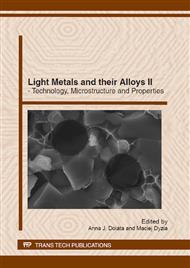p.3
p.13
p.23
p.29
p.37
p.45
p.57
p.67
Influence of Overheating Degree on Material Reliability of A390.0 Alloy
Abstract:
The object of the studies was A390.0 alloy (AlSi17Cu5Mg), similar to A3XX.X series, gravity cast into sand and metal moulds. This alloy is mainly used for cast pistons operating in I.C. engines, for cylinder blocks and housings of compressors, and for pumps and brakes. The A390.0 alloy was poured at temperatures 880 and 980°C, holding the melt for 30 minutes and casting from the temperature of 780°C. The assessment of the impact of the degree of overheating was to analysis the tensile strength. Studies were carried out on a normal-running fatigue testing machine, which was the mechanically driven resonant pulsator. For the needs of quantitative reliability evaluation and the time-to-failure evaluation, the procedures used in survival analysis, adapted to the analysis of failure-free operation with two-parametric Weibull distributions, were applied. Having determined the boundary value σ0 for Weibull distribution, the value of „m” modulus was computed along with other coefficients of material reliability, proposed formerly by the authors. Basing on the obtained results, a model of Weibull distribution function was developed for the tensile strength with respective graphic interpretation.
Info:
Periodical:
Pages:
23-28
Citation:
Online since:
August 2012
Authors:
Price:
Сopyright:
© 2012 Trans Tech Publications Ltd. All Rights Reserved
Share:
Citation:


